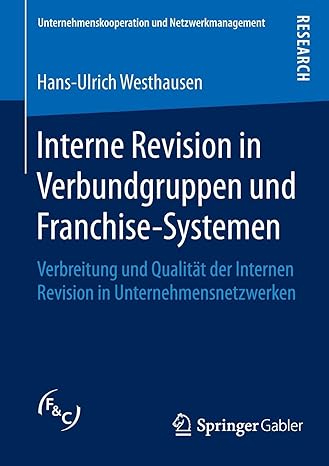Question
1) Read the following article on: Three Technologies That Will Change The Face Of Auditing: Putting flesh on the bones of technological change in auditing
1) Read the following article on: Three Technologies That Will Change The Face Of Auditing:
"Putting flesh on the bones of technological change in auditing begins with talking to the people who will affect that changeand those most affected by it. To that end, one of the most important findings of the Forbes Insights/KPMG report Audit 2025 is that four in five respondents80%say auditors should use bigger samples and more sophisticated technologies for gathering data and performing analysis in their daily work.
So, what exactly will these sophisticated technologies look like, and how will they play out in 2018 and beyond? Below are three key areas where technology will change the face of auditingwith a close-up view of how the tech itself works and what results these innovations will yield.
1. How Cognitive Technology Will Enhance Audit Quality
Cognitive technologyalso known as artificial intelligencecan plow through vast tracts of data and perform digital analysis of this data in a way that is impossible even with teams of auditors today. Cognitive technology involves algorithms that enable software to absorb information, reason and think in ways similar to humans. It also encompasses a process known as machine learning, where computers can course correct and try new strategies as they encounter obstacles or unknowns in their work.
Auditors can use cognitive technology to redesign their work so they can conduct analyses of structured and unstructured data in ways not possible just a few years ago. For example, an auditor can examine information from non-traditional sources (such as social media, TV, radio and the internet), process it with a clients financial and other records, and utilize advanced analytics to draw a clearer view of possible risks.
Auditors can then use this analysis to deliver high-quality audits that dig deeper into the data and reveal more about a company, its risks, its financial reporting controls and its operating environment, says Brian Foster, KPMGs U.S. Emerging Audit Solutions Leader.
Yet even with all the benefits of cognitive technology, the human auditor plays the capstone role. The bottom line is that cognitive technology will empower and enable our professionals to make key judgments and deliver high-quality audits in a world of exploding data and ubiquitous information, and provide our auditors with access to richer, more detailed audit evidence and valuable insight that we can use to differentiate our service proposition, Foster says.
2. The Power Of Predictive Analytics
As the name implies, predictive analytics involves using advanced data analysis techniques to make predictionsbased on probabilitiesabout the future, and may involve advanced technologies such as artificial intelligence and machine learning to refine those predictions. In the context of the high-quality audit, auditors can employ digital tools to extract information from an organizations systems, and then use predictive analytics for the purpose of identifying patterns that either align or dont align with anticipated outcomes and trends. This type of analysis is conducted for various reasons, but it is especially useful in gaining deeper insight into a clients business and financial risks.
Specifically, auditors can use client dataand combine it with industry or market datato enable a deeper and more robust understanding of the state of the business and any risks. That doesnt mean, however, that predictive analytics tells you what will happen in the future. Rather, the focus is to provide probabilities that indicate potential outcomes.
Heres how this works in real time: External auditors working with a client can use predictive analytics to assess whether the clients financial or other data conform to the expected norms for comparable historical data from both within the company as well as from companies in comparable circumstances. As this capability comes into wider use, auditors will have a powerful tool to grasp the accuracy of reported information and promote audit qualitywith comparative data as a benchmark.
3. A New Platform Dive: Smart Digital Hubs
Not long ago, auditors worked in an environment defined by landline phones, fax machines and desktop computers: In effect, they were tethered to a desk. Then mobile technology made it possible for auditors to take their workand much more vital informationoutside the office and into the field. Now, the latest wave of financial technology introduces digital hubs into the equation. Simply put, these serve as smart platforms, whereby auditors can work remotely, and in real time, utilizing data and analytics, automation and visualization.
Yet to be as effective as possible, these platforms must possess three characteristics. First, a smart platform interface must be agile and able to work in a cloud-based environment. Second, it must ideally be configured to support integration into future innovations not yet available but anticipated within the next few years. And finally, it must avoid piling layers of needless complexity onto an auditors already challenging workload.
Putting It All Together: Auditing At The Speed Of Change
Just as audit-related technology is getting faster, its also changing at a faster rate. As digital innovation speeds ahead, the audit profession needs to follow suit. The question is no longer whether the auditor needs to change; its how fast?
Answer the following questions:
A. What is your takeaway from the article? What do you think about new technologies that will affect auditing?
B. What new technology will affect auditing what is your experience or what does your research tell you?
C. Do you have experience in technologies that will affect auditing? Explain and share your experience.
2. What are audit analytics? How do they affect audits, clients, and auditors?
Step by Step Solution
There are 3 Steps involved in it
Step: 1

Get Instant Access to Expert-Tailored Solutions
See step-by-step solutions with expert insights and AI powered tools for academic success
Step: 2

Step: 3

Ace Your Homework with AI
Get the answers you need in no time with our AI-driven, step-by-step assistance
Get Started


